Kaus Media, Delta Sagittarii (δ Sgr) is an orange giant star located in the constellation Sagittarius. With an apparent magnitude of 2.70, it is the constellation’s fourth brightest star, after Kaus Australis, Nunki, and Ascella. Delta Sagittarii lies at a distance of 348 light years from Earth. It is one of the bright stars in Sagittarius that form the prominent southern asterism known as the Teapot. Together with Kaus Australis and Kaus Borealis, Kaus Media outlines the bow of the celestial Archer.
Star system
Kaus Media has the stellar classification K3 III, indicating a giant star appearing orange in colour. The star has a mass 3.21 times that of the Sun and has expanded to a size of 16 solar radii. It has an effective temperature of about 4,200 K. Its estimated age is 260 million years.
Delta Sagittarii is in fact a binary star system consisting of the class K giant and a white dwarf. Kaus Media, the giant star in the system, is a weak barium star whose spectrum shows an overabundance of s-process (slow neutron-capture process) elements, most likely as a result of mass transfer from the white dwarf.
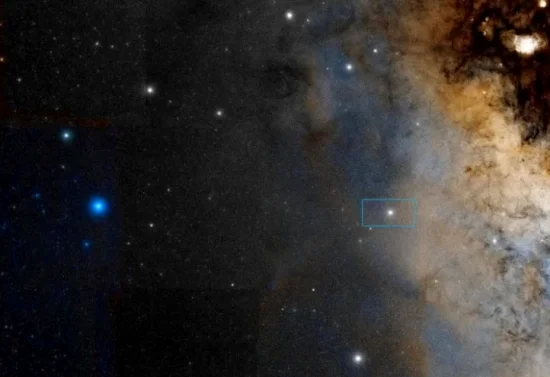
Kaus Media (Delta Sagittarii), image: Wikisky
Kaus Media also has three faint line-of-sight companions. The nearest one is a 14th magnitude star that appears 26 arcseconds away. A 15th magnitude star is located at a separation of 40 arcseconds, and a 13th magnitude star lies 58 arcseconds from Kaus Media.
Facts
Kaus Media is one of the eight stars that form the Teapot asterism that dominates the constellation Sagittarius. The other stars of the Teapot are Kaus Australis (Epsilon Sagittarii), Kaus Borealis (Lambda Sagittarii), Nunki (Sigma Sagittarii), Ascella (Zeta Sagittarii), Alnasl (Gamma2 Sagittarii), Tau Sagittarii and Phi Sagittarii.
The Egyptian astronomer Al Achsasi al Mouakket referred to Delta Sagittarii as Thani al Waridah, or “second of Warida” in his Calendarium, written in the mid-17th century. In Arabic astronomy, Kaus Media, Kaus Australis, Eta Sagittarii and Gamma Sagittarii formed an asterism known as Warida, whose name is derived from the Arabic Al Naʽāma al Wārida, meaning “the ostrich going down to the water.” Warida was one of the two asterisms representing groups of ostriches. The other group was represented by Nunki (Sigma Sgr), Phi Sagittarii, Ascella (Zeta Sgr), Chi and Tau Sagittarii. Kaus Borealis and Polis (Mu Sagittarii) were seen as the ostriches’ keepers.
Kaus Media, Kaus Australis and Alnasl (Gamma2 Sgr) formed an Akkadian asterism called Sin-nun-tu or Si-nu-nu-tum, meaning “the swallow.”
Kaus Media was used in William R. Forstchen’s 1969 novel Into the Sea of Stars. In the novel, the star is the destination of a voyage that a crew consisting entirely of women begins in 2053 and is still en route a millennium later.
Name
The traditional name of Delta Sagittarii – Kaus Media (pronunciation: /ˌkɔːs ˈmiːdiə/) – comes from the Arabic qaws, meaning “bow,” and the Latin media, meaning “middle.” The name refers to the star’s position in Sagittarius constellation. Kaus Media marks the centre of the Archer’s bow, while the brighter Kaus Australis marks the southern tip and the fainter Kaus Borealis, the northern tip of the bow. In older sources, Kaus Media is also referred to as Kaus Meridionalis.
The name was officially approved by the International Astronomical Union’s (IAU) Working Group on Star Names (WGSN) on July 20, 2016.
The Chinese know Delta Sagittarii as 箕宿二 (Jī Sù èr), or the Second Star of Winnowing Basket. Winnowing Basket is a Chinese asterism also formed by Kaus Australis, Gamma Sagittarii, and Eta Sagittarii. The asterism is one of the seven mansions of the Azure Dragon.
In Hindu astrology, Delta Sagittarii is known as Purvashada Nakshatra.
Location
Kaus Media is very easy to find because it is part of a prominent southern asterism. The Teapot lies near a rich field of the Milky Way and is easily recognizable on a clear night. Kaus Media is one of the stars that form the body of the Teapot. Northern observers can see the Teapot in the summer months, when it reaches its highest point in the sky and appears just above the southern horizon.
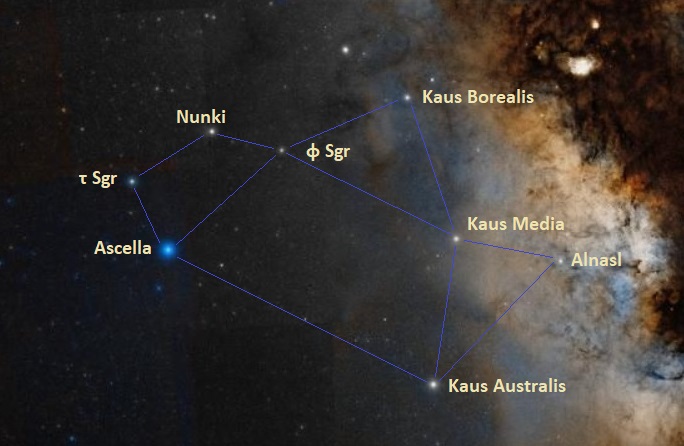
The Teapot in Sagittarius, image: Wikisky
Delta Sagittarii can be used to find the globular cluster NGC 6624, which lies only 0.8 degrees southeast of the star. The cluster has an apparent magnitude of 7.6 and occupies 8.8 arcminutes of the apparent sky. It lies at a distance of 25,800 light years from Earth. The cluster appears as a hazy patch in small telescopes.
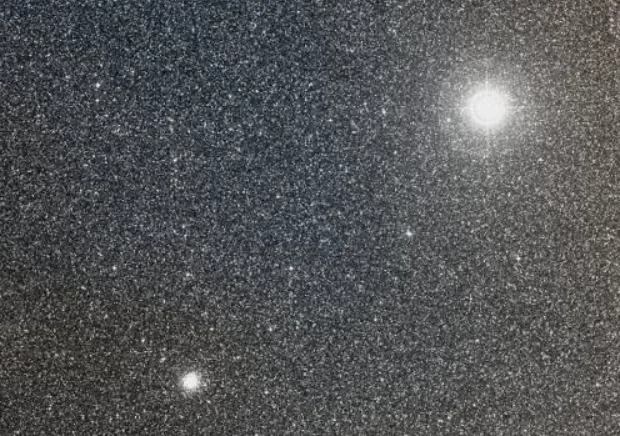
Kaus Media and NGC 6624, image: Wikisky
Kaus Media can also be used to find several bright Messier objects. The globular cluster Messier 55 lies on an imaginary line extended from the star through Ascella (Zeta Sgr). The cluster is located about 17 degrees east of Ascella.
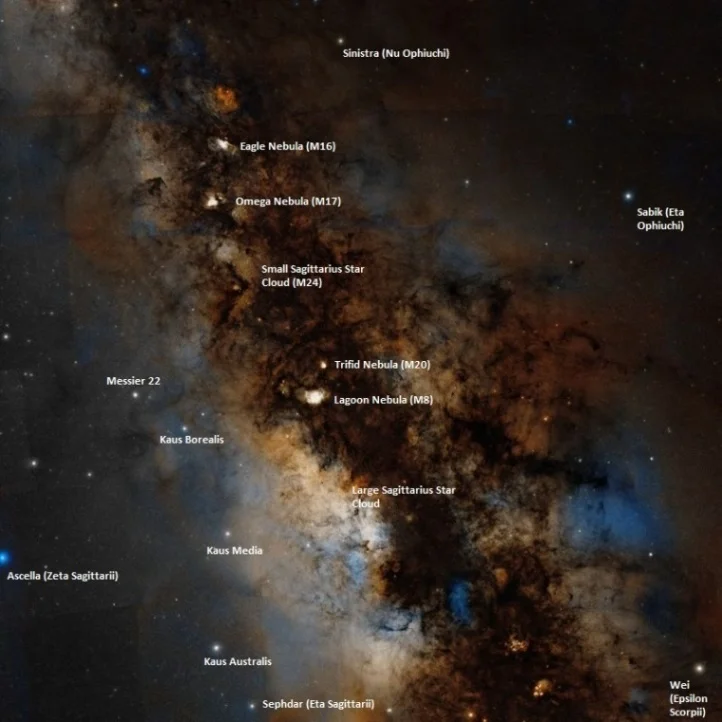
Kaus Media, the Sagittarius Star Cloud, the Eagle Nebula and the Omega Nebula, image: Wikisky
A line extended from Kaus Australis through Kaus Media northward leads to the Sagittarius Star Cloud (Messier 24), a large Milky Way star cloud about 10,000 light years away. A line from Kaus Australis drawn to the left of Kaus Media points in the direction of two famous nebulae: the Eagle Nebula (Messier 16) in the constellation Serpens and the Omega Nebula (Messier 17) in Sagittarius.
Constellation
Kaus Media is located in the constellation Sagittarius. Like other constellations in the zodiac family, Sagittarius was first listed by the Greco-Roman astronomer Ptolemy in the 2nd century CE. It is the 15th largest of the 88 constellations, occupying 867 square degrees of the southern sky.
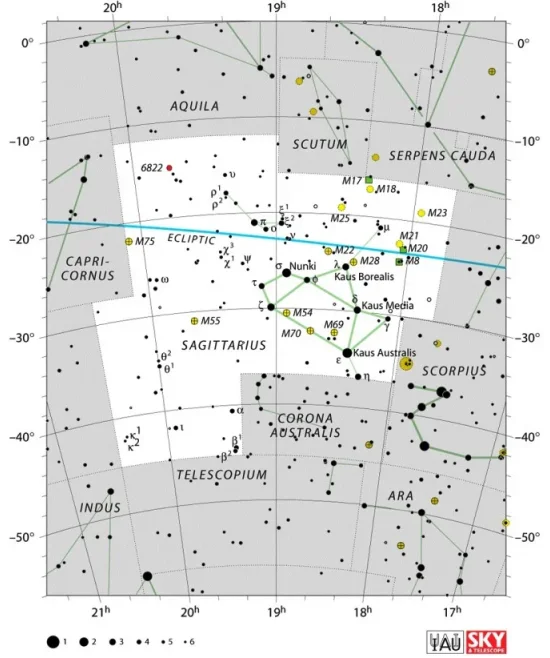
Sagittarius constellation map by IAU and Sky&Telescope magazine
Located in a dense field of the Milky Way in the direction of the Galactic centre, Sagittarius contains a great number of well-known deep sky objects. In addition to those already mentioned, these include the Lagoon Nebula (Messier 8), the Trifid Nebula (Messier 20), the open clusters Messier 18, Messier 21, Messier 23, and Messier 25, and the globular clusters Messier 22, Messier 28, Messier 54, Messier 69, Messier 70, and Messier 75.
Sagittarius is also home to the Arches Cluster and the Quintuplet Cluster, two open clusters that contain some of the most massive and most luminous stars known.
The best time of year to observe the stars and deep sky objects in the constellation is during the month of August, when Sagittarius is prominent in the evening sky.
The 10 brightest stars in Sagittarius are Kaus Australis (Epsilon Sgr, mag. 1.85), Nunki (Sigma Sgr, mag. 2.05), Ascella (Zeta Sgr, mag. 2.59), Kaus Media (Delta Sgr, mag. 2.70), Kaus Borealis (Lambda Sgr, mag. 2.82), Albaldah (Pi Sgr, mag. 2.89), Alnasl (Gamma² Sgr, mag. 2.98), Eta Sagittarii (mag. 3.11), Phi Sagittarii (mag. 3.17), and Tau Sagittarii (mag. 3.326).
Kaus Media – Delta Sagittarii
| Spectral class | K3 III |
| U-B colour index | +1.55 |
| B-V colour index | +1.38 |
| Apparent magnitude | 2.70 |
| Absolute magnitude | -1.99 |
| Distance | 348 ± 7 light years (107 ± 2 parsecs) |
| Parallax | 9.38 ± 0.18 mas |
| Radial velocity | -19.9 km/s |
| Proper motion | RA: +32.54 mas/yr |
| Dec.: −25.57 mas/yr | |
| Mass (δ Sgr A) | 3.21 M☉ |
| Radius (δ Sgr A) | 16 R☉ |
| Temperature | 4,203 ± 69 K |
| Metallicity | -0.32 dex |
| Age | 260 million years |
| Surface gravity | 0.30 cgs |
| Constellation | Sagittarius |
| Right ascension | 18h 20m 59.64354s |
| Declination | −29° 49′ 41.1659″ |
| Designations | Kaus Media, Delta Sagittarii, δ Sgr, 19 Sagittarii, HD 168454, HR 6859, HIP 89931, GC 25024, GCRV 10810, SAO 186681, FK5 687, PPM 268275, CD-29 14834, CPD−30° 5513, WDS J18210-2950A, CCDM J18210-2950A, GJ 9626, GJ 710.1, IDS 18146-2952 A, IRAS 18177-2951, 2MASS J18205962-2949412, TYC 6856-2170-1, Gaia DR2 4049506483413484672 |